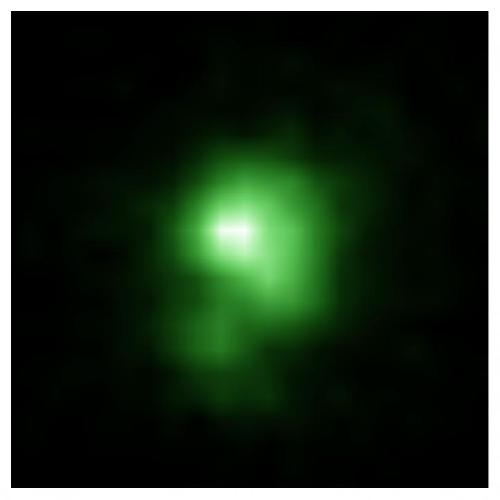After the Big Bang, the Universe expanded and, by cooling down, the matter progressively took shape. The first stars and galaxies form several hundred thousand years later. One billion year later the Universe is observed to be reheated, and hydrogen, the most abundant element, is again ionized, as it was shortly after the Big Bang. How has this important transformation, named cosmic reionization, been possible?
Astronomers have long thought that galaxies were responsible for this phenomenon. Today, an international team including researchers from the University of Geneva (UNIGE) have largely validated this hypothesis. They have indeed discovered a compact galaxy emitting a large number of ionizing photons, which are responsible for this transformation of the Universe. The article, published in Nature, opens an important new avenue for our understanding of the early Universe.
Normal matter in the early Universe, that is 14 billion years ago, consists mostly of gas. Stars and star clusters are born from clouds of gas, thus forming the first galaxies. UV radiation emitted by these stars contains numerous ionizing photons. For this reason, scientists have long suspected that galaxies were responsible for the cosmic reionization. However, to make this happen galaxies needed to «eject» these photons, which are easily absorbed, before they could escape. Despite twenty years of intensive research, no galaxy emitting sufficient radiation had been found.
To solve this problem, astronomers from Daniel Schaerer's research group at the Department of Astronomy of the Faculty of Sciences, and an international team proposed to observe «green pea» galaxies. Discovered in 2007, these galaxies represent a special and rare class in the nearby Universe. Being very compact they could host stellar explosions or power winds strong enough to «eject» the ionizing photons. Yuri Izotov, from the National Academy of Sciences of Ukraine and first author of the paper, has examined the Sloan Survey - a database of more than 1 million galaxies. From this, the team has identified approximately five thousand galaxies that match their criteria, i.e. very compact galaxies emitting very intense UV radiation. Five of those were chosen for the experiment.
 This is a Hubble Space Telescope image of the compact green pea galaxy J0925. The diameter of the galaxy is approximately 6,000 lightyears, and about twenty times smaller than the Milky Way. Credit: © Ivana Orlitová, Astronomical Institute, Czech Academy of Sciences (Prague)
This is a Hubble Space Telescope image of the compact green pea galaxy J0925. The diameter of the galaxy is approximately 6,000 lightyears, and about twenty times smaller than the Milky Way. Credit: © Ivana Orlitová, Astronomical Institute, Czech Academy of Sciences (Prague)
Using the Hubble Space Telescope, capable of detecting UV radiation, the research team found that the «green pea» galaxy J0925, located at a distance of three billion light-years, was in fact «ejecting» ionizing photons, with unprecedented intensity. This fundamental discovery shows that galaxies of this type could explain cosmic reionization, thus confirming the most commonly made hypothesis. Further observations with Hubble will firm up this result and also help to better understand the photon «ejection» mechanism and the specific galaxy types driving cosmic reionization.
Anne Verhamme, researcher at UNIGE, has also found that this «green pea» galaxy shows a very peculiar signature. Indeed, its Lyman-alpha spectrum, i.e. one of the spectral lines of hydrogen it emits, is much narrower and stronger than that of most galaxies, therefore confirming her theoretical predictions. These observations provide now the base for an efficient new method to search for galaxies responsible of cosmic reionization 13 to 14 billion years ago.
These discoveries represent an important step for studies of the early Universe. Current technology only provides us with a first glimpse on galaxies during the first billion years of the Universe existence. The future James Webb Space Telescope, whose launch is planned for 2018, is expected to revolutionize the field. It will allow astronomers to discover and study in detail the first galaxies and sources of cosmic reionization. Largely unknown so far, the early Universe starts to be revealed.
source: Université de Genève